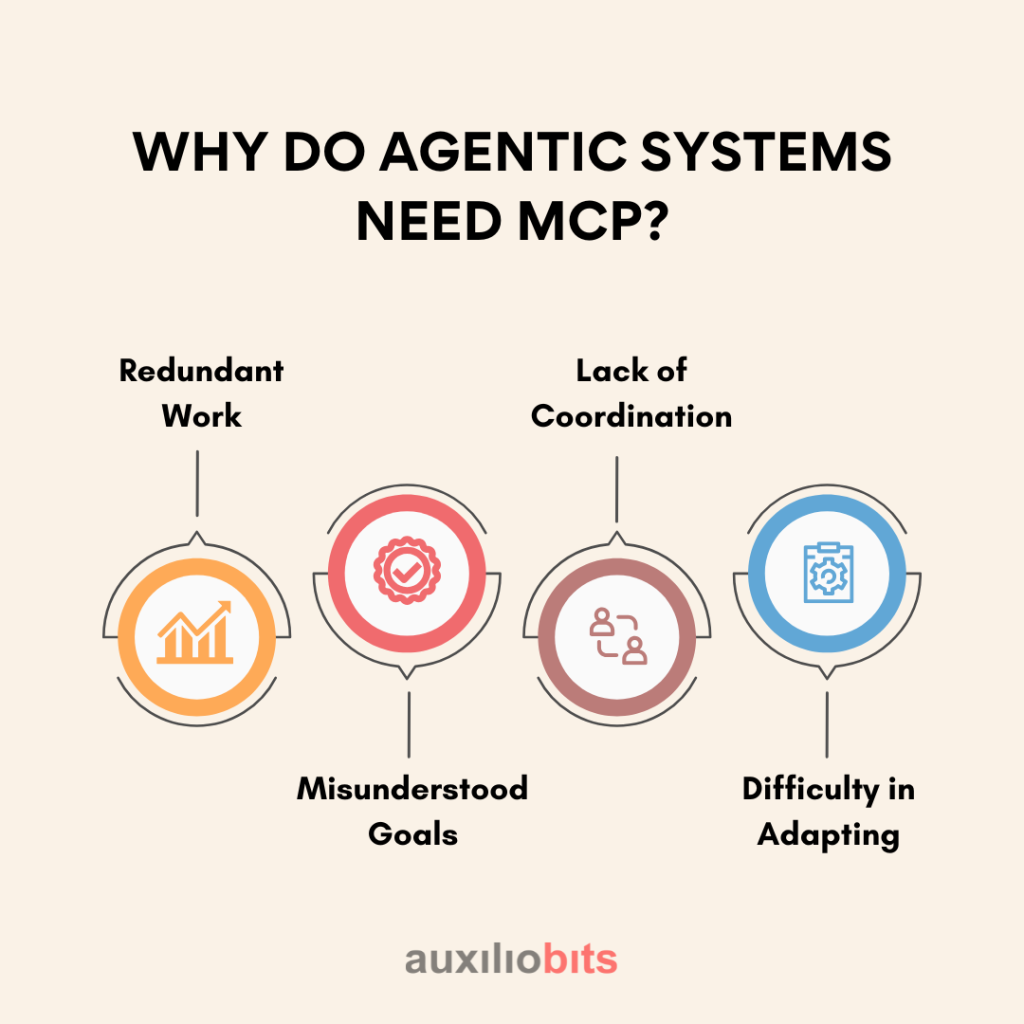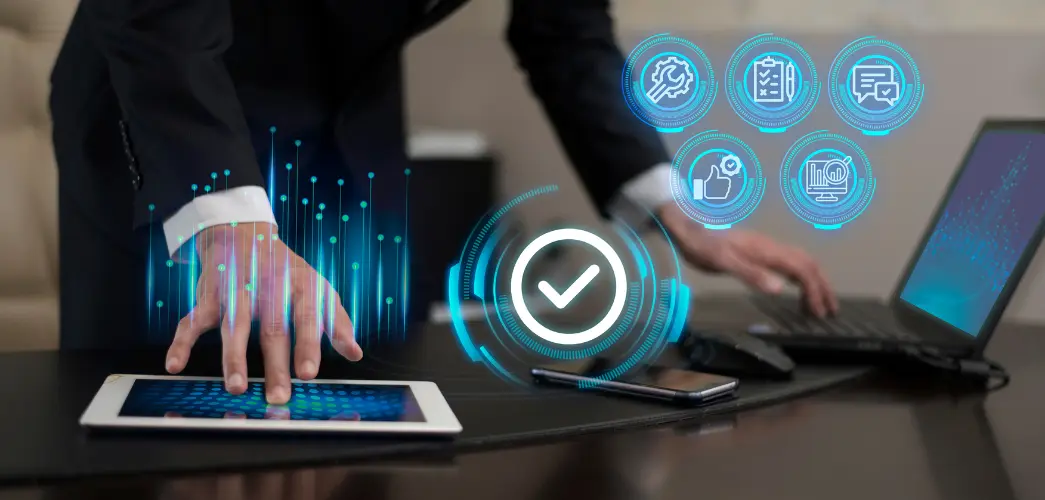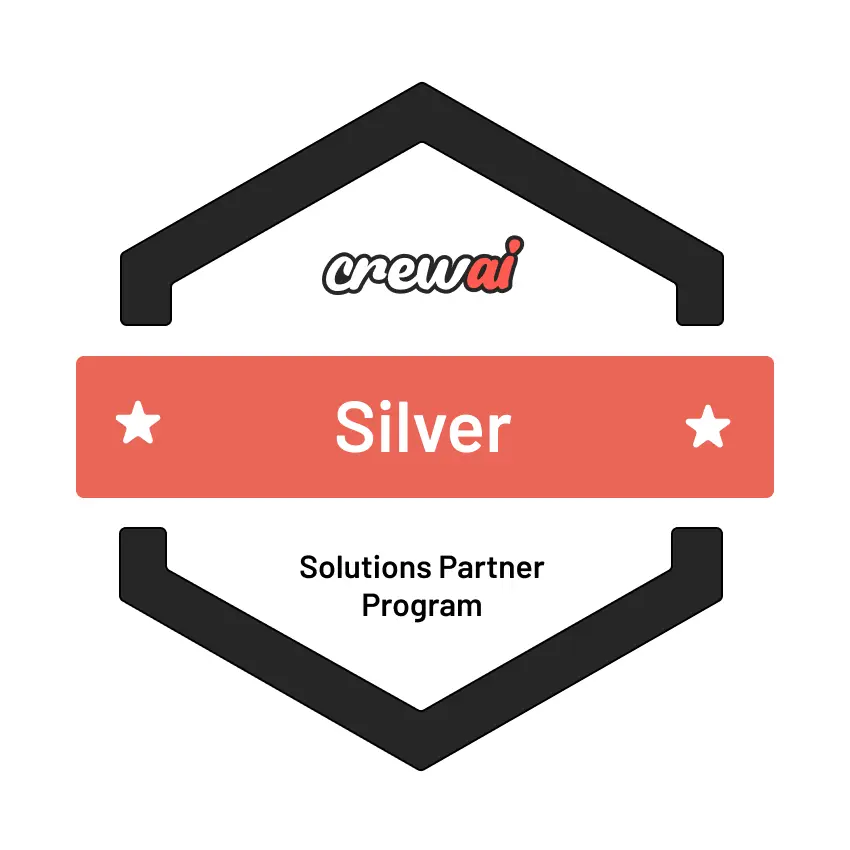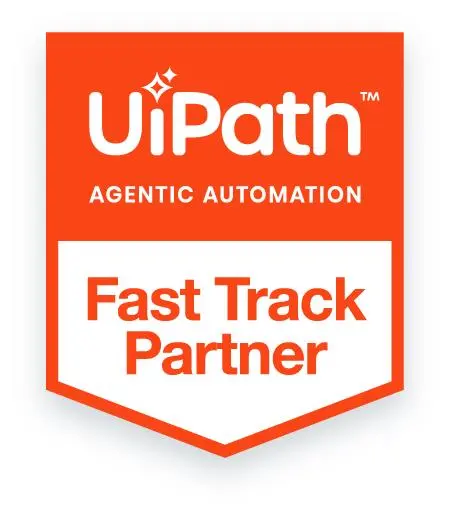
Key Takeaways
- MCP Protocol empowers multi-agent AI systems to communicate, share context, and coordinate dynamically, similar to how teams collaborate, enhancing autonomy, adaptability, and intelligent decision-making.
- Unlike rigid API calls, MCP enables fluid, context-rich interactions among agents, making AI systems more flexible, fault-tolerant, and capable of handling complex, real-world tasks.
- The Message-Context-Plan framework lets agents update their goals based on changing inputs, ensuring decisions stay aligned with evolving environments and system-wide objectives.
- By eliminating single points of failure and enabling plug-and-play intelligence, MCP facilitates the design of scalable, modular, and self-organizing AI systems.
- As AI becomes more autonomous, protocols like MCP will be central to orchestrating agent collaboration in enterprise automation, robotics, finance, healthcare, and beyond.
In today’s AI space, businesses are shifting from traditional rule-based automation to more dynamic, intelligent systems. We’re entering the era of agentic architectures—ecosystems where autonomous AI agents operate independently, capable of making decisions, learning from their environment, and collaborating to solve complex business challenges. These agents are not just task executors but proactive participants who can reason, plan, and act in pursuit of defined goals.
However, the true power of agentic systems is obtained only when multiple agents can interact seamlessly. Like human teams requiring coordination and shared understanding, AI agents need effective communication, defined responsibilities, and collaborative workflows. This is where the MCP Protocol—short for Message, Context, and Plan—plays a crucial role.
The MCP Protocol serves as the connective tissue in multi-agent systems, enabling standardized communication, situational awareness, and alignment of individual agent objectives within a shared mission. It ensures that agents can exchange information efficiently, understand the context of their tasks, and coordinate their plans without stepping on each other’s toes. The MCP Protocol provides the language and framework that allow intelligent agents to work together as a cohesive unit in real-world environments.
Let’s break it down:
1. Message
This is how agents talk to each other. They send and receive messages just like people do in a conversation. These messages can be about asking questions, sharing results, giving updates, or requesting help. The key is that all agents understand the format of these messages. This makes sure nothing gets lost in translation.
2. Context
Once the agents messaged each other, they must understand the situation. This is called context. It includes things like the goal they are trying to reach, what resources are available, what constraints exist, and what each agent is already doing. When all agents understand the same context, they can work in sync. Without context, their actions might clash or become inefficient.
3. Plan
After understanding the context, the agents make a plan. This means they decide who will do what, in what order, and how to handle any problems. A good plan helps agents avoid duplication and confusion. Each agent knows its role and what is expected of it. The plan can also change if needed — agents can adapt by going through the MCP steps again.
The MCP Protocol makes all this happen smoothly. It turns complex teamwork into a precise and repeatable process. Just like a team of humans would first talk, then assess the situation, and finally decide on a course of action, AI agents use MCP to do the same — but in a digital and automated way.
Think of MCP as a common language and strategy. It helps agents act not just smartly but also together. As agentic architectures grow, the need for structured communication becomes more critical. MCP ensures that agents do not act alone but work as a team to solve problems, reach goals, and adapt to new challenges without human direction at every step.
Also read: MLOps for Agentic AI: Continuous Learning and Model Drift Detection.
Why Do Agentic Systems Need MCP?
Imagine managing a team of people working on a big project. If they don’t talk to each other, misunderstand their goals, or start doing the same task twice, the project will quickly fall apart. There will be confusion, wasted effort, and mistakes. Now apply the same idea to a team of AI agents. They may be competent, but without a way to communicate and collaborate properly, they will face the same problems.
That’s where the MCP Protocol—Message, Context, Plan—becomes essential.
Agentic systems are built with autonomous AI agents. These agents can think, decide, and act independently. But in most real-world problems, agents don’t work in isolation. They need to function as a team. They need to divide tasks, share results, and adjust to new changes in real time. If they all act on their own without knowing what others are doing, several issues can happen:

1. Redundant Work
Two or more agents might try to solve the same part of a problem. This wastes resources and can confuse if their results are different or clash. MCP helps avoid this by letting agents share what they are doing and coordinate responsibilities.
2. Misunderstood Goals
Without a shared understanding, agents might interpret a task differently. One agent might aim to optimize for speed, while another tries to save resources, leading to conflicting actions. With MCP, agents exchange messages to clarify their mission, define goals clearly, and ensure alignment.
3. Lack of Coordination
Even if agents understand their tasks, they still need to work in a logical order. For example, one agent might depend on data from another. The dependent agent might act too early if they don’t coordinate or miss essential input. MCP allows agents to understand the context of the overall situation and create a plan that ensures proper sequencing and timing.
4. Difficulty in Adapting
In dynamic environments, things change. New data arrives, goals shift, or unexpected problems come up. When agents use MCP, they can quickly re-communicate (Message), re-assess the situation (Context), and adjust their strategy (Plan). This built-in adaptability makes the whole system more resilient and responsive.
In short, MCP brings order to agentic systems. It gives every agent a shared way to:
- Communicate clearly
- Understand the bigger picture.
- Coordinate their roles and actions.
Just like human teams use meetings, tools, and planning processes to stay on track, MCP is the digital version for AI agents. It ensures that intelligent agents act smartly, not just on their own but also work smartly together.
As agent-based AI grows in use—from customer service bots to industrial automation to healthcare assistants—MCP will be critical. It prevents chaos, boosts efficiency, and unlocks the real value of agentic collaboration. Without it, intelligent agents can become disconnected actors. With it, they become a powerful, unified force.
Key Benefits of MCP for Agentic Architectures
The MCP Protocol—Message, Context, Plan—offers many advantages for building and managing agentic systems. These benefits help AI agents work better as a team, adapt faster, and deliver more reliable results. Let’s look at the key benefits in simple terms.
1. Coordination
Coordination means working together without confusion. Each agent must know what the others are doing in a team of AI agents. Agents may do the same task twice without proper coordination or interfere with each other’s work. This can lead to delays, wasted resources, and errors. The MCP Protocol fixes this by giving agents a shared way to communicate. Through Message, agents can tell others what they are doing or ask what others are doing. Using Context, they can understand the current situation and decide what tasks are needed. Then, using Plan, they can agree on who will do what and in what order. This keeps all agents aligned and ensures that work is done efficiently and without overlap.
2. Scalability
Scalability means being able to grow a system easily. In agentic architectures, you may start with only a few agents. But you’ll want to add more agents as your system grows or tasks become more complex. Without a protocol like MCP, adding new agents can be risky. They might not know what the other agents are doing or how to fit into the system. MCP solves this by giving every agent a clear structure to follow. New agents can simply join the network, read the current messages and context, and join the existing plan. They don’t need manual configuration or custom integration. This makes scaling up fast and safe, without confusion or bugs.
3. Modularity
Modularity means breaking a system into smaller, specialized parts. In an agentic system, different agents can have different roles. For example, one agent may plan the following steps, another may perform the tasks, and another may monitor the results. These are different roles, but they still need to communicate and collaborate. With MCP, every agent follows the same communication format. All agents can understand each other, no matter their role or function. You can easily replace one agent with another or add new specialized agents without changing the rest of the system. This makes designing, upgrading, and maintaining complex agent systems easier.
4. Reusability
Reusability means using the same agent in many different projects. When an agent is designed to follow the MCP Protocol, it becomes reusable. You can use the same agent in a healthcare system, a financial platform, or a customer service bot because the way it communicates stays the same. As long as the environment supports MCP, the agent will know how to send messages, understand context, and follow plans. This saves time and cost. You don’t need to build a new agent from scratch every time. Just plug in an existing MCP-compatible agent, and it will start working immediately.
5. Transparency
Transparency means being able to see what’s happening inside the system. In AI systems, things can sometimes go wrong or produce unexpected results. To fix problems or improve performance, you need to understand what each agent did and why. The MCP Protocol helps with this by making every step in the process visible. Every message sent, every change in context, and every decision in the plan can be tracked. This makes it easier for developers to debug issues, audit behavior, and improve agent performance. It also builds trust. Users are more likely to trust the system when they see how decisions are made.
MCP vs. Traditional API Calls
In many traditional automation or software systems, tools, applications, and services communicate with each other using APIs (Application Programming Interfaces). APIs are standardized interfaces that allow different systems or software components to exchange data. While they are powerful and effective for many use cases, APIs have certain limitations compared to the more advanced MCP Protocol (Message, Context, Plan), which is designed for agentic architectures.
Let’s examine the differences between MCP and Traditional API Calls in detail to understand how MCP enhances flexibility, adaptability, and collaboration in agentic systems.

1. Rigidness vs. Flexibility
In traditional systems, APIs often operate with rigid structures. When one system needs to communicate with another via an API, both systems must follow a predefined set of rules and data formats. These rules are strict, and any deviation from the standard can cause errors or failures in communication. For example, if a system expects data in a specific format, it cannot process it if it comes in a different structure. While APIs are great for fixed, predictable interactions, they cannot adapt to unexpected situations.
On the other hand, MCP offers flexibility. It’s designed for systems where AI agents are communicating and collaborating. Agents can engage in conversational communication, allowing them to adapt to new information or changing conditions. Rather than exchanging fixed data, agents can adjust their messages based on the context of the situation. This means that agents can modify their approach based on what they learn from other agents or changes in the environment, making the system far more adaptable. This ability to evolve the communication and actions of agents is especially valuable in dynamic or complex systems.
2. Static vs. Dynamic Decision-Making
Traditional API calls often follow a predefined path. When an API is called, it performs a specific function based on the data it receives. This process is generally linear and does not adjust based on changing circumstances. If new data becomes available or if the task shifts in some way, the API cannot change its behavior without some human intervention or pre-programming.
In contrast, MCP is dynamic and context-aware. The protocol supports dynamic decision-making based on real-time changes in the environment and the agents’ context. Each agent can constantly adjust its understanding of the task and alter its actions accordingly. For example, if an agent in a supply chain management system detects an unexpected shortage, it can instantly change its plan and communicate with other agents to find a solution. Unlike traditional API calls, which are often blind to these evolving situations, MCP enables agents to respond intelligently and in real-time to the context around them.
3. Data Passing vs. Team Communication
When traditional systems use APIs, the primary interaction is data passing. One system sends a request, and another sends the required data or result back. This is a transactional exchange of information without much context or understanding of the broader system goals. It’s a machine-to-machine communication method that lacks the fluidity of human interaction.
MCP mimics a more human-like interaction, allowing agents to work together more naturally. Instead of merely sending raw data, agents communicate in a way that feels like a team conversation. Agents can discuss their findings, share their understanding of the situation, and coordinate actions based on their roles within a larger goal. This kind of team communication ensures that all agents are aligned, making it easier to achieve complex objectives. For example, a group of AI agents working in customer service could share updates, adjust strategies based on customer sentiment, and adapt to new priorities—all without rigid rules. The system’s communication process feels less like machines passing data and more like a group of individuals working together toward a common goal.
4. Task Coordination vs. Task Duplication
In traditional API systems, the communication process is often unidirectional and isolated. This can lead to problems with task duplication or inefficiency, as each system operates independently without considering the actions of others. For example, two systems might independently request the same data or perform similar tasks, wasting resources and effort.
With MCP, task coordination is central. Each agent within the system knows what other agents are doing and can adapt its actions to avoid redundancy. Using context and plans, MCP ensures that tasks are distributed efficiently and that agents are not duplicating efforts. This improves overall system efficiency and reduces waste.
Why MCP Matters for the Future?
As AI continues to advance and become more integrated into various aspects of our lives, the role of AI agents is growing rapidly. From enterprise systems to smart homes, customer service, and even educational tools, AI agents are becoming essential for automating tasks, improving efficiencies, and enabling new capabilities. However, as AI agents proliferate and become more complex, the need for a reliable communication framework that can coordinate, connect, and scale these agents becomes more critical. This is where the MCP Protocol—Message, Context, Plan—comes into play, emerging as a foundational technology that could shape the future of AI collaboration and interaction.
1. Coordinating Actions Among AI Agents
In a world where AI agents are responsible for a wide range of tasks, whether managing inventory in a warehouse, providing customer support, or controlling home automation systems, it’s important that these agents can coordinate their actions seamlessly. MCP enables this coordination by providing a standardized communication protocol for agents to exchange information, align activities, and avoid redundant or conflicting actions.
As AI systems become more sophisticated, they will need to handle complex workflows that require multiple agents to work together. For instance, a healthcare AI system may include agents that collect patient data, analyze medical records, and schedule appointments. If these agents are not well-coordinated, mistakes can happen—like scheduling a test at the wrong time or analyzing incomplete data. MCP ensures that agents stay aligned by allowing them to exchange messages, understand the task context, and agree on a plan for proceeding.
Without such coordination, AI agents could act independently, leading to inefficiencies, errors, or missed opportunities for collaboration. As AI agents become more prevalent, the MCP Protocol will become the backbone of effective coordination, making their actions more purposeful and synchronized.
2. Sharing Information Between AI Agents
One of the most potent aspects of AI agents is their ability to gather, analyze, and act on information. However, this power can only be fully realized if the agents can share information effectively. This is where MCP’s communication system is crucial.
In traditional systems, sharing information is typically done through APIs or predefined channels, but these methods don’t allow for dynamic communication or real-time adaptation. MCP changes that by enabling conversational communication, which allows agents to exchange messages in context. They can send updates, share insights, or alert other agents to new developments while maintaining a shared understanding of the environment and goals.
For example, consider a fleet of delivery drones. These drones need to communicate with each other to avoid collisions, optimize routes, and keep track of deliveries. With MCP, drones can continuously update each other about their locations, the status of their deliveries, and any potential obstacles they encounter. By sharing this information, the drones can work together more efficiently, ensuring smoother operations.
MCP’s ability to facilitate real-time, dynamic information sharing will make it essential for large-scale systems that require constant data flow between multiple agents, from autonomous vehicles to smart cities and beyond.
3. Scaling AI Systems Over Time
As enterprises and individuals increasingly adopt AI-driven solutions, the systems they rely on will need to scale to handle growing demands. AI agents must expand and adapt to new tasks, users, and environments. A scalable way to add new agents without disrupting the system or causing confusion must be found for this to happen effectively.
MCP supports this scalability by providing a flexible and modular framework that allows new agents to join a system with minimal friction. As a business or environment’s needs grow, new agents can be integrated into the system and immediately begin interacting with existing agents using the same standardized protocol. This allows businesses to expand their AI capabilities without worrying about compatibility or communication issues.
For example, in a customer service system, a company may start with a few agents handling common inquiries. Over time, as the business grows, they may add specialized agents handling more complex queries, processing transactions, or even managing multilingual support. MCP ensures that all these agents can communicate effectively and work together, even as the system expands.
This kind of scalability is essential in ensuring that AI systems can grow with businesses’ needs, making MCP an essential component for the future of AI-driven enterprises, smart cities, and the broader AI ecosystem.
4. MCP as the Backbone of the AI Agent Economy
As AI agents become more ubiquitous across various sectors, from automation to healthcare and beyond, there will be a growing need for a universal communication protocol that ties all these agents together. Just as HTTP became the foundation for the modern web and TCP/IP powers the internet, MCP could become the backbone of the AI agent economy.
The AI agent economy refers to the increasing reliance on autonomous agents to perform tasks, make decisions, and interact with each other in real-time. This economy will include everything from AI-driven customer service bots to autonomous delivery systems, smart homes, and enterprise AI assistants. For these systems to function seamlessly, they need a way to communicate, collaborate, and scale. MCP provides this by allowing agents to send messages, understand each other’s context, and work toward a common goal.
As the number of AI agents continues to rise, the MCP Protocol could evolve into the de facto standard for communication in agent-based systems, enabling businesses, governments, and individuals to build smarter, more integrated environments. In this sense, MCP is not just a protocol for today—it is a key enabler of tomorrow’s AI-driven world, laying the groundwork for a new age of intelligent, autonomous systems working together.
Conclusion
The MCP Protocol is more than just a technical standard — it’s a language of collaboration for AI agents. In a world where AI is moving from task-specific bots to intelligent, autonomous teams, MCP enables:
- Clear communication,
- Shared understanding,
- And coordinated planning.
As organizations explore agentic architectures to drive automation, research, and innovation, MCP will be a critical enabler, much like electricity is for machines.
If you want to build AI systems that are scalable, intelligent, and truly autonomous, MCP is not optional — it’s essential.








